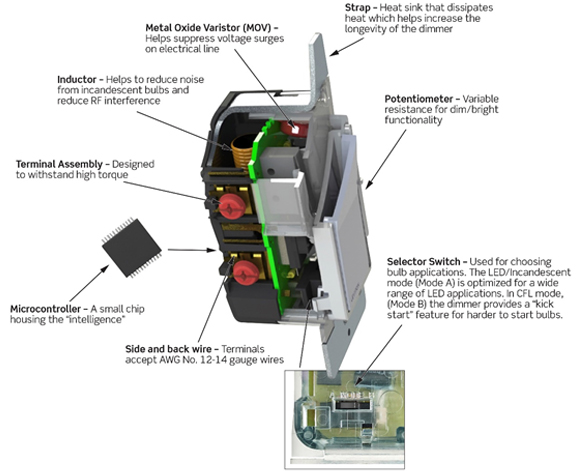Tech Talk – How Universal Dimmers Work

When electricity was first introduced into the home, folks were happy to be able to simply turn a switch and watch as the electric light turned on. It made life much easier; and the notion of being able to control the degree of light level was not even a thought. Incandescent dimmers made their debut in the theater in the early 1930's, where they were used to adjust lighting for different scenes during performances – and it was no easy task. Dimming required manual operation of large panels and was an inexact science. It wasn't until nearly 30 years later that the technology was developed to bring dimming into the home. Today, we've come a long way in terms of operation, design and now, meeting the challenge of bulb compatibility. Enter the Universal Dimmer.
Universal Dimmers evolved from traditional incandescent dimmers out of necessity. With newer bulb technology introduced with CFLs and LEDs, it was only a matter of time before these energy-efficient luminaries would replace incandescent bulbs in homes and homeowners would expect equal, or better, performance when dimming them.
So, how do Universal Dimmers work?
Dimmers control the brightness of lighting by controlling the amount of electrical energy supplied to the bulb.
They do this using an electrical component called a triac.

- The triac is a very fast-acting switch that can turn ON and OFF hundreds of times per second.
- When a dimmer is turned to full brightness, the triac keeps almost all of the power turned ON to supply the lighting it controls.
- But when the lighting is dimmed, the triac turns the power OFF for a longer period so the bulb receives less electrical energy and in turn gives off less light.
Universal Dimmers generally contain a microcontroller. By way of the microcontroller, they are able to understand the type of bulb installed (Incandescent, CFL, LED) by the position of the selector switch which is set by the user. This process allows the Universal Dimmer to customize operation accordingly for optimal performance by using intelligence based upon algorithms to take input signals from the bulb in use and translate that information to control the triac appropriately to meet the requirements of different bulb technology.
Other key components of Universal Dimmers

A Word on Bulbs
Although there are applications where dimmable LED and dimmable CFL bulbs will operate with an incandescent dimmer, in general, an incandescent dimmer will provide inconsistent performance when used with dimmable CFL and dimmable LED bulbs, making a Universal Dimmer the preferred option. A major issue is in the design of each bulb type. The incandescent bulb by nature represents a simple resistive load with a linear response to the dimmer set point. LED and CFL loads by design are quite complex compared to the incandescent bulb and this presents technical challenges to an incandescent dimmer.

How Bulbs Work
|
Incandescent |
Electricity used to heat metal filament. Releases up to 90% of energy as heat. |
|
CFL |
Electric current flows between electrodes at each end of a tube containing gasses producing UV light which becomes visible when it strikes phosphor coating on inside of bulb. Takes 30 seconds to 3 minutes to become fully lit. |
|
LED |
Electrical current passes through a semiconductor material, which illuminates the LEDs. More light, less heat. |
In the end, Universal Dimmers are all about making it easier to seamlessly control lighting levels with your choice of bulb. Just remember, for best results CFL and LED bulbs must be labeled "Dimmable"; and do refer to Bulb/Dimmer compatibility charts posted by bulb and dimmer manufacturers for the ideal pairing!


